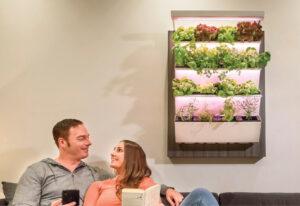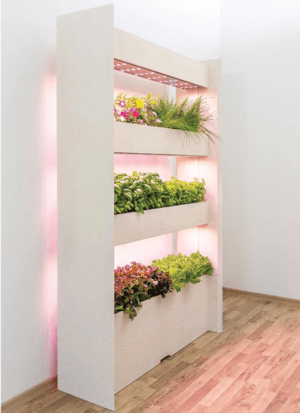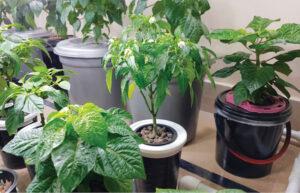 Hydroponic gardening has garnered quite a following in recent years, as it serves as a phenomenal way to garden for those who want to try an alternative to old-school, soil-based gardening. Simply put, hydroponic gardening is the process of growing plants in a bath of water mixed with nutrients that help promote the plants’ growth. These nutrients are full of the same ingredients contained in various fertilizers and can come in both a powder and liquid form. Just like fertilizer for a soil garden, these nutrients can be easily found at garden supply stores, the garden department of your local home improvement store, or online. The exact type of nutrients needed is largely dependent on the plants you decide to grow. An advantage of a hydroponic garden is that it does not require the use of soil. That said, with most hydroponic systems, the seeds do need something to be planted in. The substance (often called a substrate) used in place of soil is dependent on the plant being grown and the hydroponic system being used. The ideal substrate allows the seeds to latch onto something as their roots begin to form while also maximizing the amount of water the plant consumes. Lava rocks are a common and affordable substrate that can support a large variety of plant life, but other substrates like peat moss or other minerals are also very popular. Instead of relying on sunlight as a source of energy and light, many hydroponic gardeners will utilize UV lamps to be able to precisely control the amount of light the plants are being exposed to. By using artificial light in a controlled environment, hydroponic gardeners can grow any kind of plant year-round. However, using the sun as a light source is feasible when growing a hydroponic garden.
Hydroponic gardening has garnered quite a following in recent years, as it serves as a phenomenal way to garden for those who want to try an alternative to old-school, soil-based gardening. Simply put, hydroponic gardening is the process of growing plants in a bath of water mixed with nutrients that help promote the plants’ growth. These nutrients are full of the same ingredients contained in various fertilizers and can come in both a powder and liquid form. Just like fertilizer for a soil garden, these nutrients can be easily found at garden supply stores, the garden department of your local home improvement store, or online. The exact type of nutrients needed is largely dependent on the plants you decide to grow. An advantage of a hydroponic garden is that it does not require the use of soil. That said, with most hydroponic systems, the seeds do need something to be planted in. The substance (often called a substrate) used in place of soil is dependent on the plant being grown and the hydroponic system being used. The ideal substrate allows the seeds to latch onto something as their roots begin to form while also maximizing the amount of water the plant consumes. Lava rocks are a common and affordable substrate that can support a large variety of plant life, but other substrates like peat moss or other minerals are also very popular. Instead of relying on sunlight as a source of energy and light, many hydroponic gardeners will utilize UV lamps to be able to precisely control the amount of light the plants are being exposed to. By using artificial light in a controlled environment, hydroponic gardeners can grow any kind of plant year-round. However, using the sun as a light source is feasible when growing a hydroponic garden.
Hydroponic gardening is a very sustainable method for home gardeners to grow an array of plant life using a minimal amount of space compared to traditional gardens. These systems are contained and do not have the potential environmental hazards that can be associated with runoff from various fertilizers, manures, and other chemicals often vital for a traditional garden. Despite water being the main component of hydroponics, these types of gardens use significantly less water compared to traditional gardens. Indeed, some setups are capable of using up to ten times less water. The reason these systems can save this much water is that hydroponic gardens are designed to deliver water directly to the crop’s roots. Traditional gardening can lose a substantial amount of water due to it being absorbed by the soil instead of the crops and from evaporation. Furthermore, many hydroponic systems allow gardeners to recycle the same water for extended periods as long as the system is supplied with fresh air to keep the water oxygenated. Therefore, many systems require some form of an air pump (usually called a bubbler) to ensure the water in the system remains usable. One downside of hydroponic gardening is that it can be hard to grow crops that require a lot of space, such as melons or corn. Nevertheless, there is more than enough variation in what you can grow, making hydroponics a great fit for both the novice and longtime gardener. There is a variety of ways to get into hydroponic gardening, but here are two relatively simple methods to begin your hydroponic journey.
Store-bought Systems
 The most hassle-free way to start a hydroponic garden is to simply purchase a hydroponic gardening kit. There are countless brands and styles of these products, but they all function in similar fashions. A hydroponic garden kit is an empty box with a lid that contains a varying number of spaces for gardeners to fill with whatever kind of crops they wish to grow. Each space on the box’s lid contains a plastic mesh basket called a netting pot, which is kind of like a small kitchen colander, that you can fill with whatever substrate and plant you desire. Additionally, these pre-made hydroponic systems typically come with a UV light attached to them. Often, those lights have a timer built in so that you can ensure your plants are receiving the appropriate amount of light with little to no active effort. As if that was not easy enough, most hydroponic kits also have indicator lights that will turn on when you need to add fresh water or plant food to the garden. While these kits are simple to set up and use, they do require an initial investment of around $60 to $200 depending on the size and features of the system.
The most hassle-free way to start a hydroponic garden is to simply purchase a hydroponic gardening kit. There are countless brands and styles of these products, but they all function in similar fashions. A hydroponic garden kit is an empty box with a lid that contains a varying number of spaces for gardeners to fill with whatever kind of crops they wish to grow. Each space on the box’s lid contains a plastic mesh basket called a netting pot, which is kind of like a small kitchen colander, that you can fill with whatever substrate and plant you desire. Additionally, these pre-made hydroponic systems typically come with a UV light attached to them. Often, those lights have a timer built in so that you can ensure your plants are receiving the appropriate amount of light with little to no active effort. As if that was not easy enough, most hydroponic kits also have indicator lights that will turn on when you need to add fresh water or plant food to the garden. While these kits are simple to set up and use, they do require an initial investment of around $60 to $200 depending on the size and features of the system.
DIY Methods
 Just like the store-bought versions, there are endless options in terms of design when building a homemade hydroponic garden. Elaborate designs can be complex to assemble, especially when you are just getting into hydroponics. However, for those who are new to the hobby or are just curious about the process, there is no shortage of simple DIY hydroponic setups. Perhaps the easiest setup would be the Kratky method. All that is needed to build a Kratky system at home is the following: a container with a lid (5-gallon buckets work great), a netting pot, a substrate (such as lava rocks), plant nutrient mix, distilled water, and a plant seedling. Once you have your materials, the entire process from construction to planting should only take an hour or so. First, you are going to want to cut a hole in the top of your container’s lid so that you can fit your netting pot into it. The circumference of the hole you cut should be slightly smaller than the rim of your netting pot so that the roots of your plant are submerged in water while the top of the plant remains dry and exposed to light. Next, you are going to fill the bucket up with a mixture of the distilled water and plant nutrients. The exact quantities of nutrients needed vary from plant to plant, and most plant nutrient containers will have instructions on how much to use. After that, go ahead and plant your seedling in your netting pot filled with your substrate of choice and place that into the hole you cut into your container. At this point, you will want to decide whether you will use the sun or a UV lamp as a light source. Using a UV lamp is great if you want to keep the system inside, which can be necessary if you are growing a plant that is not in season. However, if the plant is in season and you are able, setting the system outside is effective and does not require additional equipment. A little rain will not devastate your garden, but keeping your Kratky covered on the back patio or front porch is advisable when you are expecting substantial amounts of rain. If you do choose to set the garden outside, it may be worth painting your Kratky system black to help keep the inside cool. All you need to do after that is wait. The secret to the Kratky method is that you put all the water and nutrients the plant will need for its entire growing cycle at the start of the planting process, so there is no need to add more water or nutrients after planting. The water mixture in your container will be consumed by your plant, slowly depleting over time. As the amount of water reduces, the space in your container will fill with air, which in turn keeps the water remaining in the container oxygenated. By the end of the plant’s growing cycle, there will only be a little of the water mixture left. It is best to dilute the remaining mixture with an equal amount of ordinary tap water and either reuse it in another hydroponic setup or dispose of it directly into a drain. Do not pour the mixture out into your lawn, as the runoff can negatively affect your local ecosystem. While the Kratky method system can only produce one plant at a time, the setup process is both simple and affordable, so you could build multiple systems to support a wider range of plant life. The Kratky method is a great entry point into hydroponics but is certainly not the only method. If you have success growing using this method, it is well worth taking the next step to explore other DIY hydroponic setups, such as ebb-flow systems, aquarium systems, or hanging systems.
Just like the store-bought versions, there are endless options in terms of design when building a homemade hydroponic garden. Elaborate designs can be complex to assemble, especially when you are just getting into hydroponics. However, for those who are new to the hobby or are just curious about the process, there is no shortage of simple DIY hydroponic setups. Perhaps the easiest setup would be the Kratky method. All that is needed to build a Kratky system at home is the following: a container with a lid (5-gallon buckets work great), a netting pot, a substrate (such as lava rocks), plant nutrient mix, distilled water, and a plant seedling. Once you have your materials, the entire process from construction to planting should only take an hour or so. First, you are going to want to cut a hole in the top of your container’s lid so that you can fit your netting pot into it. The circumference of the hole you cut should be slightly smaller than the rim of your netting pot so that the roots of your plant are submerged in water while the top of the plant remains dry and exposed to light. Next, you are going to fill the bucket up with a mixture of the distilled water and plant nutrients. The exact quantities of nutrients needed vary from plant to plant, and most plant nutrient containers will have instructions on how much to use. After that, go ahead and plant your seedling in your netting pot filled with your substrate of choice and place that into the hole you cut into your container. At this point, you will want to decide whether you will use the sun or a UV lamp as a light source. Using a UV lamp is great if you want to keep the system inside, which can be necessary if you are growing a plant that is not in season. However, if the plant is in season and you are able, setting the system outside is effective and does not require additional equipment. A little rain will not devastate your garden, but keeping your Kratky covered on the back patio or front porch is advisable when you are expecting substantial amounts of rain. If you do choose to set the garden outside, it may be worth painting your Kratky system black to help keep the inside cool. All you need to do after that is wait. The secret to the Kratky method is that you put all the water and nutrients the plant will need for its entire growing cycle at the start of the planting process, so there is no need to add more water or nutrients after planting. The water mixture in your container will be consumed by your plant, slowly depleting over time. As the amount of water reduces, the space in your container will fill with air, which in turn keeps the water remaining in the container oxygenated. By the end of the plant’s growing cycle, there will only be a little of the water mixture left. It is best to dilute the remaining mixture with an equal amount of ordinary tap water and either reuse it in another hydroponic setup or dispose of it directly into a drain. Do not pour the mixture out into your lawn, as the runoff can negatively affect your local ecosystem. While the Kratky method system can only produce one plant at a time, the setup process is both simple and affordable, so you could build multiple systems to support a wider range of plant life. The Kratky method is a great entry point into hydroponics but is certainly not the only method. If you have success growing using this method, it is well worth taking the next step to explore other DIY hydroponic setups, such as ebb-flow systems, aquarium systems, or hanging systems.
 There is nothing quite as satisfying as eating food you have grown yourself, and with hydroponic gardening achieving that feat is easier than ever. Hydroponic gardens are an efficient, sustainable, and fun way to grow food without the space required for a traditional soil garden. Store-bought systems can offer an easy way to try out hydroponics with very little background knowledge, but the systems can be a bit pricey. Building your system allows you to have the freedom to decide what you want to grow and in what quantities. For new hydroponic gardeners, the Kratky method is one of the easiest do-it-yourself ways to begin experimenting with hydroponics, as it is both cheap and essentially hands-off once the system has been built. These are only two examples of an expansive array of methods to grow crops via hydroponics; if either has sparked interest in the hobby, it is well worth looking more into hydroponic gardening. Ditch the soil and give hydroponics a try!
There is nothing quite as satisfying as eating food you have grown yourself, and with hydroponic gardening achieving that feat is easier than ever. Hydroponic gardens are an efficient, sustainable, and fun way to grow food without the space required for a traditional soil garden. Store-bought systems can offer an easy way to try out hydroponics with very little background knowledge, but the systems can be a bit pricey. Building your system allows you to have the freedom to decide what you want to grow and in what quantities. For new hydroponic gardeners, the Kratky method is one of the easiest do-it-yourself ways to begin experimenting with hydroponics, as it is both cheap and essentially hands-off once the system has been built. These are only two examples of an expansive array of methods to grow crops via hydroponics; if either has sparked interest in the hobby, it is well worth looking more into hydroponic gardening. Ditch the soil and give hydroponics a try! ![]()
Andy Baker
Home & Yard Magazine




